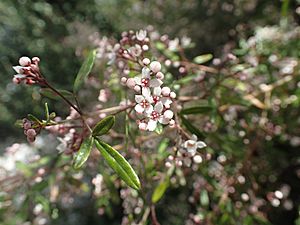Hill zieria facts for kids
Quick facts for kids Hill zieria |
|
|---|---|
 |
|
| Zieria collina in the Australian National Botanic Gardens | |
| Conservation status | |
| Scientific classification | |
| Genus: |
Zieria
|
| Species: |
collina
|
The Hill Zieria (Zieria collina) is a special plant. It's part of the citrus family, called Rutaceae. This plant is found only in a small part of south-east Queensland, Australia. It's a big, bushy plant that spreads out. Its leaves have three small parts, and its flowers are tiny with four white petals.
What the Hill Zieria Looks Like
The Hill Zieria is a spreading shrub. It has soft, velvety hairs all over it. This plant can grow up to 3 m (10 ft) tall.
Its leaves grow in pairs, one across from the other. Each leaf is made of three smaller parts called leaflets. These leaflets are shaped like ovals or narrow spears. They are about 12–20 mm (0.5–0.8 in) long and 3–5 mm (0.1–0.2 in) wide.
The top side of the leaflets is a darker green. It might have a few hairs and small bumps. The bottom side is covered with many soft, velvety hairs. The stem that holds the leaf is about 1–8 mm (0.04–0.3 in) long.
The flowers are bright white and small, about 7 mm (0.3 in) across. They grow in groups of 15 to 30. These groups appear where the leaves meet the stem. Each flower has four small green parts called sepals and four white petals. Like other zieria plants, it only has four stamens, which are the parts that make pollen.
The Hill Zieria usually flowers from August to October. But you can often see flowers at other times too. The fruit opens about six weeks after the flowers bloom.
How it Was Named
The Hill Zieria was first officially described in 1932. A scientist named Cyril Tenison White gave it its formal name. He published his description in a science journal.
The second part of its scientific name, collina, is a Latin word. It means "of a hill." This name tells us where the plant likes to grow.
Where it Lives
This zieria plant grows near the edges of rainforests. You can find it on and around Tamborine Mountain in Queensland. It sometimes grows very close together, forming thick patches. It seems to grow well after the area has been disturbed, like after a bushfire.
Protecting the Hill Zieria
The Hill Zieria is listed as "Vulnerable." This means it's at risk of disappearing. The Australian government protects it under a law called the Environment Protection and Biodiversity Conservation Act 1999.
The biggest danger to this plant is other plants that are not native to Australia. These "introduced species" can take over the area where the Hill Zieria grows. One of the main problem plants is lantana (Lantana camara).


